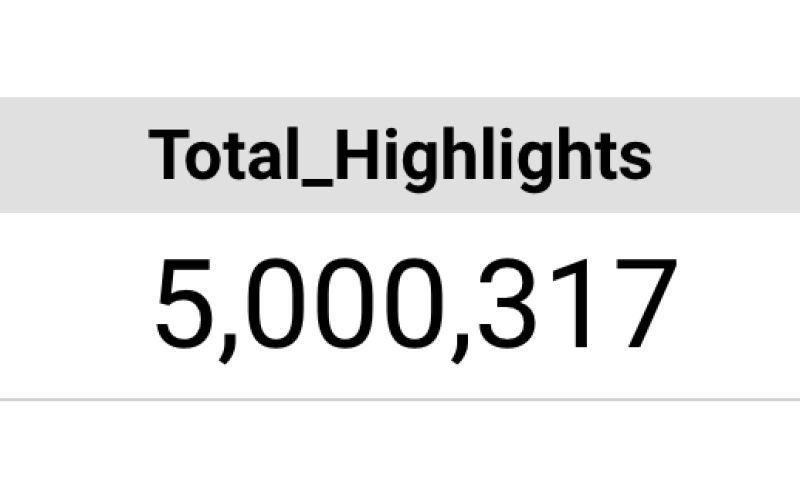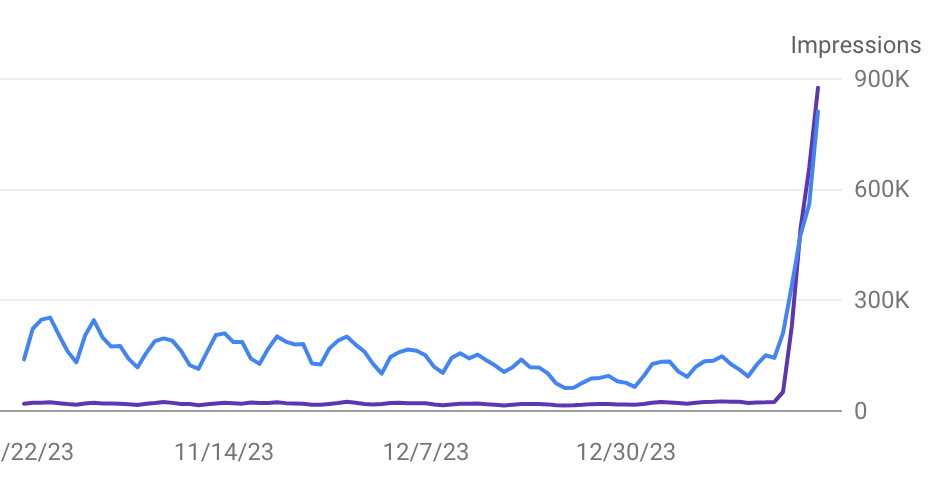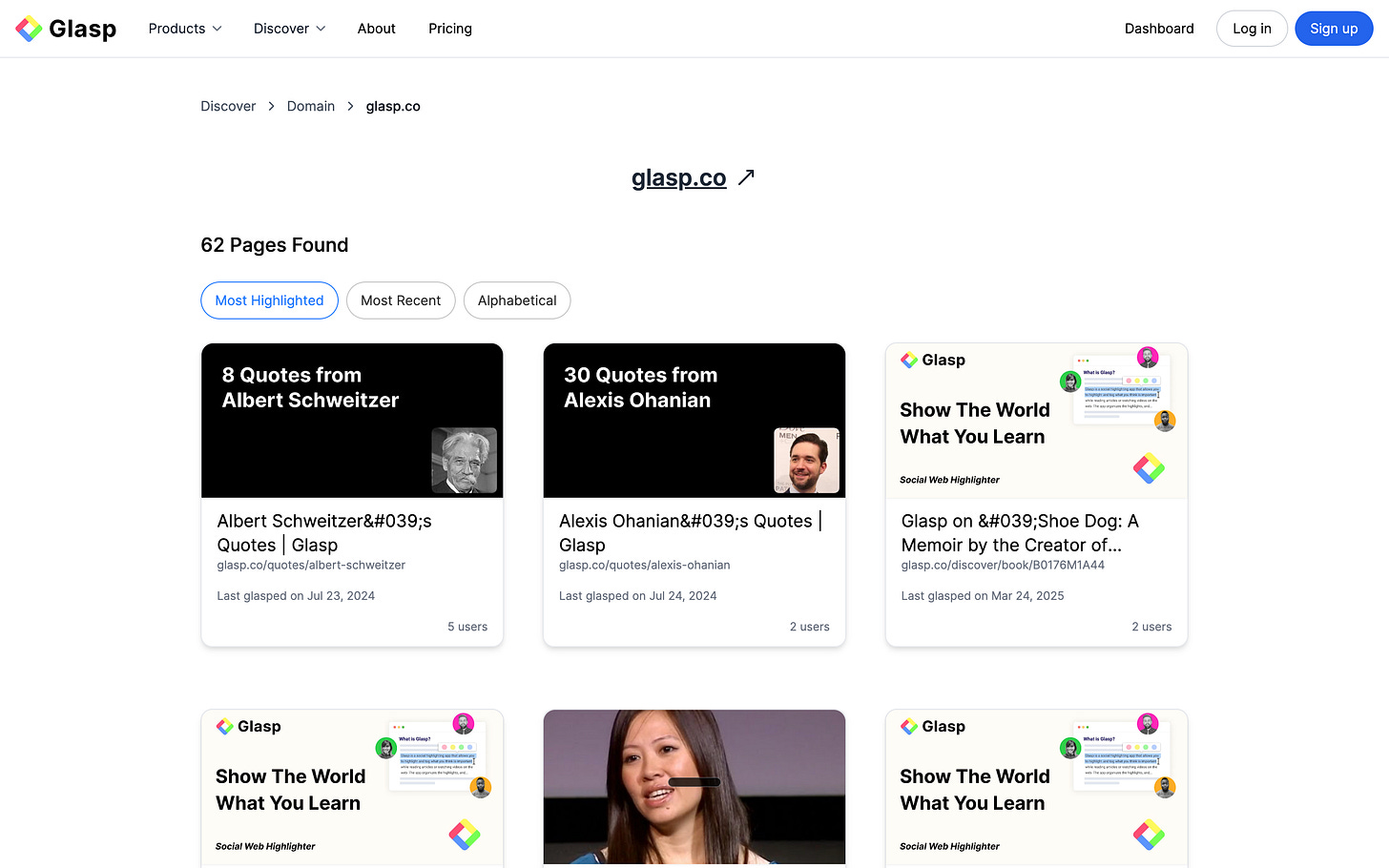Hatching Growth #13: From UGC to SEO — Turning Highlights into Discovery
Glasp’s note: This is Hatching Growth, a series of articles about how Glasp organically reached millions of users. In this series, we’ll highlight some that worked and some that didn’t, and the lessons we learned along the way. While we prefer not to use the term “user,” please note that we’ll use it here for convenience 🙇♂️
If you want to reread or highlight this newsletter, save it to Glasp.
Recap: #1–#12 in one glance
#3: How We Rode the AI Wave with Side Projects Before It Exploded
#8: How We Doubled Down on YouTube Summary with Programmatic SEO
#9: Acquisition-First, the AARRR Ladder, and Turning Core Actions into a Growth Engine
#12: AEO in Practice: Memory Hacks, Prompt Injection Experiments, and Honest Results
Introduction
In the last edition, we explored AEO (Answer Engine Optimization) — how generative models like ChatGPT are shaping a new layer of discoverability. This time, we’re returning to one of Glasp’s earliest ideas: leveraging user-generated content (UGC) for SEO.
In Glasp’s context, UGC refers to the collective knowledge created by users through highlights, notes, and comments. For each web article highlighted on Glasp, we aggregate all users’ highlights, extract the Top Highlights, and enrich them with user comments and notes to create a dedicated Glasp page. These pages turn personal reading insights into publicly discoverable knowledge, forming the foundation of our UGC→SEO system.
This strategy was part of our growth logic from the very beginning, following the same framework introduced in Hatching Growth #2 — identifying scalable, compounding acquisition channels built on user activity.
But even though the idea existed from day one, it wasn’t until January 2024 that we finally released our UGC→SEO system. Here’s why it took that long — and what we learned along the way.
Why It Took a Year to Ship (Even with the Idea in Hand)
1. Built from Vanilla JS (before React/Next.js)
When we first built Glasp, both founders were non-engineers, learning to code as we went. We started with vanilla JavaScript — not because we wanted to master the fundamentals, but simply because we didn’t know other options existed yet.
At the time, we weren’t aware of frameworks like React or Next.js. Later, through conversations with engineers at other startups and by studying how other products were built, we learned about Next.js — and realized it was becoming the mainstream approach, especially for UGC-based systems that benefit from structured, framework-driven SEO. That realization came much later. In the early days, everything was hand-coded in JS — line by line.
That decision had pros and cons:
Good: It forced us to understand how the web actually works under the hood.
Bad: Development was slow. Even adding a new tutorial page or updating content on Glasp could take hours.
That’s also why, as mentioned in Hatching Growth #2, we initially wrote tutorials on Medium and guest-posted on external blogs. It wasn’t mainly for backlinks — it was because updating content directly on Glasp took too much time.
At the same time, Medium was easy to write on and had a strong internal recommendation engine that could drive more traffic than search engines. Its high domain authority also meant that tutorials published there could rank well even in the early days, long before Glasp’s own domain gained strength.
2. Domain Rating (DR/DA) Was Too Low Early On
As we explained in Hatching Growth #8, early Glasp had a low domain rating, and we focused on media reach strategies — collaborations, backlinks, and side projects — to gradually build credibility and visibility.
During 2022–2023, this approach steadily raised our authority. Then, with the breakout success of YouTube Summary, Glasp’s DA finally began to climb, signaling that it was time to build the UGC→SEO system we had been planning since the early days.
3. UGC Needed to Reach Critical Mass
Even with the right infrastructure, UGC SEO only works when there’s enough content. Highlights are Glasp’s core action, but they’re also a high-friction behavior. Without enough volume of public highlights, auto-generating pages would have had minimal impact.
By January 2024, Glasp users had collectively created just under six million highlights, spanning roughly one million unique web articles. That estimate comes from Glasp’s long-term average ratio of about 5 highlights per article. At that scale, user-generated content finally reached the density needed to generate meaningful, content-rich pages. Once that threshold was crossed, we decided to ship the UGC→SEO system.
(We had crossed five million highlights a few months earlier, in October 2023, as noted on LinkedIn.)
4. The First Attempt: explore.glasp.co
Before launching on the main domain, we tested the concept on a subdomain: explore.glasp.co in mid-2023.
There were two reasons for this:
it allowed us to separate the project from the main Glasp codebase, and
we could switch only explore.glasp.co to Next.js first, while keeping the main site stable.
At the time, we didn’t yet know Next.js, so we used this subdomain as a way to learn and experiment with the framework before adopting it across Glasp.
The project was developed by a software engineer at Glasp, and while the prototype worked, it became a black box — we couldn’t iterate quickly or experiment with improvements.
Later, we realized another key issue: Subdomains don’t inherit the root domain’s authority. So even though explore.glasp.co was part of Glasp, it didn’t benefit from glasp.co’s DR/DA. That meant we were essentially building strength from scratch — a double effort. Eventually, we decided to migrate everything back to the root domain.
UGC → SEO: Turning Highlights into Pages
When we migrated to Next.js in January 2024 (enabling SSR), we finally implemented the system. For each public web article highlighted by Glasp users, we aggregated all highlights and displayed the Top 5 highlights on a dedicated page. These pages were crawlable by Google and automatically added to our sitemap.
On the first day, impressions on Google Search Console exceeded 900,000 — a sudden surge that confirmed the scale and visibility potential of the system.
But almost immediately, we discovered that some users might have highlighted API documentation or other potentially sensitive materials. Concerned about privacy and data exposure risks, we decided to take everything down — deleting all generated pages and submitting index removal requests to Google Search Console.
Fortunately, no data leaks occurred. Still, those two intense days taught us a lot — both about operational safety and how much more carefully we needed to move as the platform grew.
After that incident, we introduced a domain-based whitelist and blacklist system to manage visibility. Domains on the whitelist allow highlights to be made publicly visible, while those on the blacklist can still be highlighted privately, but their content will never appear publicly or be crawled by search engines.
If you’d like your own domain to be whitelisted on Glasp, please reach out following the guidelines linked below. Whitelisting means that portions of your public content may be hosted as highlight pages on Glasp, with backlinks to your original site. Glasp never performs link insertions or paid placements, but we’re open to partnering with publishers who are interested in traffic sharing and content hosting through highlights.
👉 How to Improve SEO with Glasp?
Shortly after stabilizing the UGC→SEO system, we extended the same concept to Kindle Highlights. For each book highlighted by Glasp users, we automatically aggregated the Top Highlights into a dedicated page, making them discoverable and crawlable by Google.
If you’d like to import your Kindle Highlights beyond Kindle’s export limit, please visit the guide below.
👉 How to Copy and Paste Kindle Highlights Beyond the Export Limits
Results: Visibility, Not Yet Growth
After the system stabilized, Glasp’s daily impressions again exceeded 900K in Search Console. We also saw heavy crawling from AI bots, suggesting the content was being used for model training.
While the visibility was massive, it didn’t yet translate into major user acquisition.
Traffic-to-signup conversion remained low — partly because highlight pages attract curious readers, not necessarily content creators.
Still, the project created clear benefits:
Backlinks from new referring domains
Better content discovery within Glasp
Improved crawl frequency and domain authority over time
We also found notable differences by region: SEO performance in English-speaking markets (especially the US) was highly competitive, while non-English regions — particularly Japan — showed 3× higher efficiency in impressions and click-throughs.
Even so, since our focus remains on the English-speaking world, we haven’t whitelisted non-English domains for now.
Consolidating Content Under glasp.co
After running the UGC→SEO project, we realized the next logical step was to consolidate everything under glasp.co itself.
Previously, Glasp’s blog.glasp.co (managed via Ghost) hosted tutorials and Glasp Talk articles separately from the main site. But as our domain strength improved, it became clear that distributing content across multiple subdomains diluted SEO impact and fragmented the overall experience.
So we decided to migrate not only tutorials, but also Glasp Talk posts into the main Glasp domain — using our newly built Post feature to recreate and host them natively on Glasp. This unification made our ecosystem more cohesive, easier to update, and better positioned for community-driven discovery.
Takeaway
The UGC→SEO system represents the culmination of years of groundwork — from building Glasp by hand in vanilla JS, to raising domain authority, to finally migrating to a scalable Next.js architecture and consolidating everything under one domain.
We learned a few key lessons from this journey:
SEO takes time, but as a system, it can become a long-term growth engine.
Even if traffic and user growth from UGC SEO were limited in the short term, the real value lies in building, owning, and maintaining the system itself. Once in place, it can continue generating traffic and users automatically, without ongoing manual effort.Understanding technology deeply matters. When you know how things actually work, you can design better, more efficient systems. Since most innovation originates in technology, we were reminded that staying close to new tools and frameworks is essential for long-term creativity and speed.
We’re entering an era of content abundance, accelerated by AI. That means traditional SEO strategies are becoming less effective — AI crawlers may increase traffic requests, but that doesn’t necessarily translate into real users or growth.
The concept remains valuable, but we’ll need to evolve it for an AI-saturated landscape.As platforms grow, experimentation becomes harder. When user volume increases, even small experiments carry greater risk. It’s best to run fast, small experiments early, before systems and expectations solidify.
After growth, precision matters. Once a product reaches scale, every update or experiment needs to be done with care and intentionality — understanding its downstream effects on the community and platform.
What’s Next
In the next edition, we’ll explore one of two themes that have been top of mind lately — either:
how early-stage teams can approach fundraising with creativity and discipline, or
what we’ve been learning behind the scenes through Glasp Talk and its growing community of thinkers and builders.
Whichever direction we take, the goal remains the same: to share real experiments and lessons that help small teams grow smarter — not just bigger.
Partner with Glasp
We currently offer newsletter sponsorships. If you have a product, event, or service you’d like to share with our community of learning enthusiasts, sponsor an edition of our newsletter to reach engaged readers.
We value your feedback
We’d love to hear your thoughts and invite you to our short survey.






Really insightful deep dive into the evolution of Glasp’s UGC→SEO system.
I love how this piece connects technical progression (from vanilla JS to Next.js) with strategic growth thinking, showing that real compounding growth often comes from patient system-building, not quick hacks.
The reflections on scaling, privacy safeguards, and precision at later stages really resonate especially the reminder that SEO isn’t just about traffic, but about creating durable discovery loops powered by genuine user activity. 👏